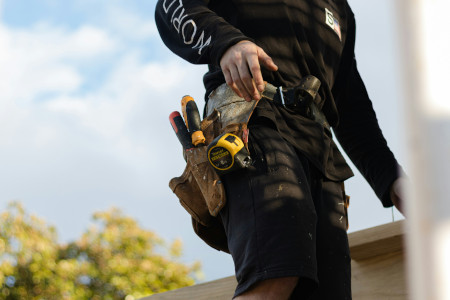Disclaimer
Market Financial Solutions are a bridging loan and buy-to-let mortgage provider, not financial advisors. Therefore, Investors are encouraged to seek professional advice. The information in this content is correct at time of writing.

Property flipping, where it’s done right, can be a very profitable endeavour. Generally, the most common form of flipping involves buying undervalued properties, fixing them up through refurbishments, and selling them on for a profit. Many investors caught onto how profitable this can be during the pandemic. In late 2021, Hamptons estate agents found that 19,000 properties had been flipped since the start of the pandemic, generating average profits of £48,190. While there is demand within the market, investors should keep a cool head. Some may assume flipping is easy or straightforward, but this is a grave underestimation. Here are a few tips for how to successfully flip houses and minimise the risks involved.
Source: Sky News
1. Account for taxes and other costs
The first tip on how to successfully flip houses is keeping an eye on secondary costs. While the cost of the property itself will likely be the single dearest element, investors will need to pay for legal fees, tradesmen, estate agents etc.
Not to mention what’ll be owed to the taxman. Property buyers may need to factor in Capital Gains Tax, Stamp Duty, Income Tax and more. There are so many costs to factor in that investors may want to seek out expert guidance. Accountants and other professionals can help get these costs under control.
For those who need a basic refresher, the Government’s website has details on when and where property related taxes are levied. There are also public advisory services such as Money Helper and Citizens Advice.
2. Get contingency funds in place
Tip number two on how to successfully flip houses: Factoring in the expected costs on their own may not be enough. Investors who have budgeted for everything will still need money set aside to cover unexpected bills.
Ask yourself, what would happen to your plans if your builder pulls out at the last minute and you have no funds left to hire another? Could you cover the extra cost if supplies needed for a refurbishment end up twice as expensive than expected?
According to Check a Trade, an additional 10-15% should be added on top of a total renovation budget for contingency. This could be used to cover any nasty and unexpected surprises.
Source: Check a Trade
3. Think outside obvious sources for finding home flipping opportunities
Exploring non-traditional sources is key to successfully flipping houses. While obvious sources such as Zoopla, Rightmove and estate agents can list properties ripe for flipping, opportunities can slip under the radar elsewhere.
So here is our 3rd tip for house flipping: Undervalued, or underappreciated properties often pop up in auction houses. You can also buy off-market or even look into probate properties. By seeking out more niche sources, untapped potential could be discovered.
4. Resist excessive refurbishment plans
Once the work gets started, investors will have to resist the urge to throw the kitchen sink at the property. Extensive refurbishment works can be tempting. However, not only will it raise costs, it can also lower the desirability of the property itself.
You may think your efforts are simply modernising a decrepit home, but external perspectives may think otherwise. The changes could be deemed “too much”. If a house is no longer in keeping with the tone or aesthetic of a neighbourhood, would-be buyers could view it as an eyesore.
Additionally, if you keep on adding more and more upgrades to a property, it can delay when people move in or buy it from you. This will delay your return. And with the average renovation cost for a 3-bed house sitting anywhere between £44,000 and £110,000, investors may not be able to delay a return for long.
Source: Check a Trade
5. Hold back on personal taste
Another crucial aspect of how to successfully flip houses is not letting personal taste dictate refurbishments. This could be particularly problematic for investors who fancy themselves as designers.
As an example, perhaps an investor insists on having an open plan kitchen as part of the refurbishment plans. But, maybe what most buyers want are kitchens with L-shaped designs.
To keep up with what’s desirable, investing in certain trade magazines or websites could pay dividends down the line. Ideal Home, or Homes & Gardens can keep investors up to speed on what’s trendy in the interior design world. Architecturally, Dezeen or Architectural Digest could prove useful.
And as always, hiring professionals can help take the design challenges completely out of your hands.

6. Know your target market
One of the best tips for house flipping is to account for the market you’re targeting and what kind of demand lays within the target area.
Doing a bit of research ahead of time could help create clearly defined plans and secure success. Investors may risk converting old offices into flats for city workers, only to find out the area is actually popular with large families looking for houses.
Keeping up with the news could prove especially important. In recent years, workers flocked to the countryside or coast as flexible working became the norm. As such, some buyers may assume investment by the sea would be a good bet. However, coastal demand has started to ease according to Rightmove, while many tenants are returning to London in droves.
Source: Property Reporter, SW Londoner
7. Be clear on your end goal
Keeping the person(s) at the other end of the flipping in mind from the outset is crucial – and not just from a design perspective. Investors may hope an obvious type of buyer will present itself during the process, but this is risky.
A great tip for successful house flipping to follow: Ask yourself if you are flipping the property for another buyer or for renters. These will present two very different sets of priorities.
8. Keep an eye on short-term blips while focusing on long-term demand
Over the long term, supply and demand will likely be the determining factor in any investment. But, other external economic forces can still impact a project, even if it’s just in the short-term.
The state of the wider economy will impact how much demand there is for property. Where recession or inflation looms, buyers may struggle to find the funds for a new home.
These considerations can get quite specific too. Perhaps you’re targeting renters working in education. If the industry suddenly faces massive funding cuts or layoffs, you may find demand for your property dry up.
Keeping an eye on the news and certain economic indicators could help limit the damage. Obvious examples include interest rate decisions from the Bank of England or inflation figures from the ONS. Investors won’t be able to control how the wider economy fares, but they can at least put contingency plans in place.
9. Look out for your competition
Successful house flippers stay vigilant about competition. You’re like not the only one attempting to do what you’re doing. There are plenty of investors out there who may have more funds than you, be quicker and have more experience.
The second you put your guard down, a rival bidder could swoop in. To reduce this risk, investors could try to find market opportunities away from the mainstream. Having access to fast, short-term finance like bridging loans can also help buyers act quickly and not get caught up in delays.
10. Promote your hard work
Proper promotion is vital to successfully flip houses. It will be of little use putting in renovation efforts if you don’t promote the property during the endgame. Rising demand in the wider market doesn’t guarantee success for your individual project. Sometimes, even if you build it, they won’t come.
To ensure your efforts are recognised, you will want to make sure the property in question is advertised and promoted in the right places. Working with online estate agents, trade magazines and even social media can get your investment seen by the desired end-buyers.
11. Aim high, but realistic
Of course, investors should always hope for the best result and do what they can to achieve it. But at the same time, realistic goals should be prioritised. Overvaluations will only damage your balance sheet.
Just because property prices are rising, it doesn’t give you the right to set the price as you see fit. If the average property in your area is selling for £300,000, it would be foolish to expect your property to go for £600,000.
To get an idea of what your property will eventually sell for, even after refurbishment, you should check the price data history for properties in the area. Both Rightmove and Zoopla have historic data on house prices which can be easily accessed on their websites.
The Complete Guide to
Auction Finance
A simple guide to advance your portfolio
- Comprehensive overview
- Auction finance types
- Useful tools
- Industry stats & more





